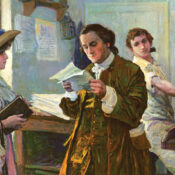When Mary Tyler Moore began her freshman year at Hollywood’s Immaculate Heart High School back in 1951, her mother told her, “Be sure and take a typing course so when this show business thing doesn’t work out, you’ll have something to fall back on.” Mary responded in typical teenage fashion. From that moment on, “the very last thing I ever thought about doing was taking a typing course,” she recalls.
The show business thing worked out, of course. She debuted as Happy Hotpoint, the elf in dozens of TV appliance commercials. After appearances on several TV series, Moore hit it big as the beautiful suburban housewife, Laura, on The Dick Van Dyke Show and the perky 30-something single woman on The Mary Tyler Moore Show, not to mention stage, feature film, and made-for-television work that garnered her seven Emmy Awards, a Tony, and an Oscar nomination, among many other accolades. Only recently, when she sat down to write Growing Up Again, did she regret ignoring her mom. “I don’t know how to use a computer or do any of that,” she admits, so she persevered with a supply of pencils and legal pads, and wrote the book longhand.
Unlike her 1995 autobiography, After All, her second book is less about life as an award-winning actress and more about living with diabetes. All the proceeds are earmarked for the Juvenile Diabetes Research Foundation (JDRF), an organization she serves as international chairman. “I felt there was a need for a book like this,” she says. “I didn’t want to lecture, but I wanted to communicate that I have shared the same feelings and experiences that other diabetics have. I wanted them to know that things get better when we’re disciplined and do our part in managing the disease.”
But she hasn’t always practiced what she teaches. In her book, she describes that awful day, almost 40 years ago, when she received two pieces of life-changing news. First, she had lost the baby she was carrying, and second, lab tests revealed that she had type 1 diabetes. In a childlike act of rebellion against the rules that accompanied the diagnosis, she left the hospital and promptly treated herself to a box of glazed doughnuts. Years would pass before she realized she had to grow up — again — and take control of her diabetes, not let it control her. Only then did she kick her three-pack-a-day cigarette habit, overcome her addiction to alcohol, and begin to follow a balanced diet and exercise regimen.
Although her disease has affected her vision and forced her to the sidelines of the dance floor that she once dominated, she refuses to indulge in self-pity. “Everybody on earth can ask, ‘why me?’ about something or other,” she insists. “It doesn’t do any good.
No one is immune to heartache, pain, and disappointments. Sometimes we can make things better by helping other people. I’ve come to realize the importance of that as I’ve grown up this second time. I want to speak out and be as helpful as I can be.”
She works tirelessly on behalf of JDRF, especially in November, American Diabetes Month and relies on the encouragement of her husband, Dr. Robert Levine, a cardiologist 18 years her junior. The two met in a New York emergency room where he treated her mother, and they have been a couple ever since. Their age difference is not an issue, she says. For her part, she’s proud of Robert’s medical expertise but she’s confident that she can hold her own when the topic is diabetes.
“He’s wonderful,” she says of the man she calls her “younger suitor” in her new book’s dedication. “He’s very patient with me and respectful of what I know about my diabetes. He’s the first one to say, ‘You know more about your condition than I do.’ And that’s true, of course … there’s no substitute for living with it.”
Become a Saturday Evening Post member and enjoy unlimited access. Subscribe now



